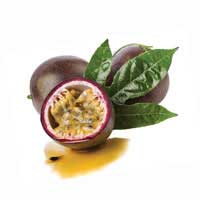 Full List of Fruits
Full List of Fruits  Granadilla fruit
Granadilla fruitGranadilla fruit
![]() Introduction of Granadilla fruit
Introduction of Granadilla fruit
Scientific name - Passiflora ligularis
Granadilla, also known as passion fruit, is a tropical fruit native to South America. It has a unique flavor and is widely consumed in many parts of the world. The scientific name of this fruit is Passiflora edulis and it belongs to the family of Passifloraceae. It is an oval-shaped fruit with a wrinkled, leathery skin that ranges in color from yellow to dark purple.
Granadilla otherwise referred as Sweet granadilla or Grenadia is native to mountain regions of Bolivia, Venezuela and Colombia. The fruit measures 6.5-8 cm in length and has diameter ranging from 5.1- 7cm. The rind is hard and slippery which forms the outer shell, where seeds are embedded on a soft padding. The seeds are surrounded by gelatinous transparent pulp. The pulp possesses sweet taste and it is used as a flavoring agent in drinks. The fruit typically appears in orange and yellow color with small light markings.
![]() Nutritional Value of Granadilla fruit
Nutritional Value of Granadilla fruit
| Nutritional Value | |
|---|---|
| Proteins | 0.340-0.474g |
| Fat | 1.50-3.18g |
| Crude fiber | 3.2-5.6g |
| Minerals: | |
| Calcium | 5.6-13.7mg |
| Iron | 0.58-1.56mg |
| Phosphorus | 44.0-78.0mg |
| Vitamins: | |
| Vitamin B1 | 0.00-0.002mg |
| Vitamin B2 | 0.063-0.125mg |
| Vitamin B3 | 1.42-1.813mg |
| Vitamin C | 10.8-28.1mg |
![]() Medicinal Uses of Granadilla fruit
Medicinal Uses of Granadilla fruit
Medicinal Uses of Sweet Granadilla fruit
|
![]() Propagation of Granadilla fruit
Propagation of Granadilla fruit
Propagation of granadilla fruits is possible through both seeds and cuttings. To propagate granadilla through seeds, the seeds must be collected from ripe fruits and planted in a moist, well-drained potting mix. It is necessary to keep the soil consistently moist, but not waterlogged, during the germination process. It typically takes about two weeks for the seeds to germinate. After germination, the seedlings should be transplanted into larger containers and grown in a warm, sunny location.
Propagation of granadilla through cuttings is a more reliable method of propagation. To propagate from cuttings, select a healthy stem that is at least six inches long and free of any damage. Cut the stem just below a node, making sure you have a few leaves on the cutting. The cutting should then be placed in water, or a moist potting mix, and kept in a warm, sunny location. Rooting hormone can be applied to the cutting to help promote root development. After a few weeks, the cutting should have developed roots and can be transplanted into a larger container.
No matter which propagation method is used, the granadilla plants should be grown in a location that receives full sun and in well-draining soil. The plants should be watered regularly, but be careful not to overwater. Fertilize the plants every two to three weeks with a balanced fertilizer. Pruning is also important to maintain a healthy, vigorous plant. Prune the plants to keep them from becoming too top-heavy and to encourage new growth.
Granadilla fruits can be harvested when they are ripe, usually about two to three months after the flowers have bloomed. To harvest, cut the fruits from the vine with scissors, and be sure to leave the stem attached. The fruits should be handled with care, as they are easily bruised. Store the harvested fruits at room temperature, or in the refrigerator.
Granadilla fruits are a delicious and nutritious treat. They are rich in vitamins, minerals, and antioxidants, and can be eaten fresh or used to make jams, jellies, and sauces. With a little patience and effort, it is possible to propagate granadilla vines and enjoy the fruits of your labor.


















